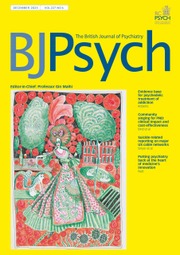Born in Switzerland in 1864, Adolf Wölfli pioneered what the painter and sculptor Jean Debuffet (1901–1985) defined as ‘Art Brut’ (raw art). This genre transcended conventional frontiers, notably encompassing work from self-taught psychiatric in-patients. Through this, creative expression from socially marginalised individuals sought legitimacy and validation, exemplified by Wölfli's unbounded compositions.
During childhood, Wölfli's father, who had alcohol use disorder, abandoned the family home, resulting in financial impecunity. Consequently, Wölfli was forced to become an indentured child agricultural labourer (a so-called Verdingkinder), recurrently enduring physical and sexual abuse, and was orphaned upon his mother's death in 1873. Wölfli's early adulthood was characterised by occupational and personal instability, and in 1890 he was incarcerated for 2 years for attempted sexual assaults. Following his release, he was again detained for a similar offence in 1895.
Subsequently, Wölfli was evaluated at the Waldau Psychiatric Hospital (now the University Psychiatric Services in Bern). He was diagnosed with ‘dementia paranoides’ (likely classifiable as schizophrenia in modern systems) and was adjudged to be socially dangerous but not criminally liable, leading to his indefinite admission at Waldau. Initially, his severe symptoms and violent behaviours persisted; however, around 1899, Wölfli commenced drawing, which reportedly helped ameliorate these issues.
Throughout 35 years of in-patient care until his death in 1930, Wölfli generated over 25,000 pages of artistic compositions. One treatment report depicted his style as ‘very stupid stuff’ and ‘a chaotic jumble’. Later, Dr Walter Morgenthaler (1882–1965) attended to Wölfli as his primary physician, encouraging his artistic pursuits for their therapeutic and aesthetic intent. Having left Waldau, Morgenthaler penned a 1922 monograph, titled Madness and Art: The Life and Works of Adolf Wölfli (Ein Geisteskranker als Künstler (Adolf Wölfli)). Following Wölfli's death, Dubuffet presented several of his works at the inaugural 1949 Art Brut exhibition; currently, Bern's Museum of Fine Arts houses much of his portfolio.
Morgenthaler's and Dubuffet's acts functioned as retrospective canonisation, contextualising and rendering non-normative phenomenology tangible through artistic curation. Hence, expression that may otherwise be considered esoteric became a valid object of criticism, in turn challenging regressive ideologies about mental illness. For instance, as Wölfi's 1910 drawing Irren-Anstalt Band-Hain (Insane-Aslyum Band Hain) (Fig. 1) portrays, his oeuvre is typified by horror vacui (a conceptual fear of empty spaces), in which he filled blank voids with exhaustive detail.

Fig. 1 Irren-Anstalt Band-Hain by Adolf Wölfli (1910). Coloured pencils on paper, 99.7 × 72 cm, Lausanne, Collection de l'Art Brut. Public domain.
Irren-Anstalt's patterned rigidity may reflect both figurative and literal attempts to impose structure on disorder. The ostensibly all-seeing eyes could imply paranoid and eschatological undertones, possibly foregrounding anxieties about the artist's own moral standing after his offences. Indeed, this sense of inner conflict is reminiscent of what Dr Eugen Bleuler (1857–1939), the long-time director of the Burghölzli facility (now the University Hospital of Psychiatry Zurich) and former assistant doctor at Waldau in the 1880s, would describe as ‘Schizophrenie’ (literally ‘split mind’). Interestingly, Irren-Anstalt also shares similarities with Daniel Paul Scherber's writings (1842–1911). A near-contemporary German judge, Scherber outlined his experiences of probable schizophrenia, depicting paranoic and religious events, in which godly rays targeted his nerves; akin to Wölfli, Schreber's text gave structure and expression to this phenomenology.
Today, we encourage readers to reflect on Wölfli's aesthetics and the wider agency of Art Brut, which offer glimpses into historical frameworks and past psychiatric developments in Switzerland and beyond.





eLetters
No eLetters have been published for this article.